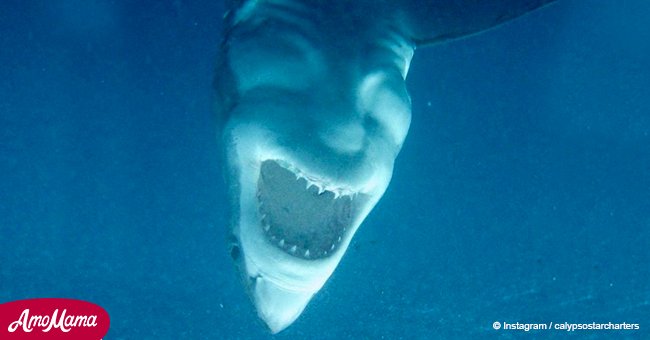
Photo of a shark taken at an unusual angle quickly became a viral optical illusion
A diver shared an eery image of the Ocean's greatest predator, a great white shark.
A diver from an Australian underwater tour guide company posted a strange photo on Instagram of what appeared to be a grinning face floating eerily in the deep blue waters of the Great Barrier Reef.
Calypso Star Charter's offers the brave an opportunity to go swimming with sharks - in a shark cage, of course - and that is where this photo was taken.
The startling image was shared on September 16, 2018, and is quickly going viral on the Internet when people realize they are looking at an upside-down photograph of a great white shark.
"Honestly thought you were playing with filters. Very cool."
Comment, Calypso Star Charter, September 16, 2018.
IT LOOKS EXACTLY LIKE BATMAN'S ARCHENEMY - THE TERRIBLE JOKER
The photo may look like an image of the Joker - one of Batman's most charismatic villains - but when turned upside down it turns out to be a great white shark swimming over the divers.
Once inverted the strange illusion vanishes, and the true subject of the photograph is clear and unmistakable. So much so that people wondered if the photo had been enhanced in any way, or altered by the application of filters.
WHAT CAUSES THIS OPTICAL ILLUSION?
The effect is akin to 'Inversion' - a powerful optical illusion. The human brain, faced with an image that is inverted will try to make sense of it, imposing visual order on the unfamiliar. This effect has been demonstrated by an experiment called 'The Thatcher illusion.'
TURNING PUBLIC PERCEPTION OF SHARKS UPSIDE DOWN
Sadly, the public image of sharks is also inverted. These magnificent predators are labeled as dangerous man-eating monsters due to their depiction, mostly in movies, the first of which was the 1975 Steven Spielberg iconic hit "Jaws." Since then, sharks have been laboring under the weight of bad press.
MORE PEOPLE EAT SHARKS THAN SHARKS EAT PEOPLE
According to the World Wildlife Fund, the statistics show that the odds of getting attacked and killed by a shark are 1 in 3,748,067; whereas the chances of being struck by lightning are 1 in 79,746, drowning 1 in 1,134, a car accident 1 in 84, stroke 1 in 24. The really fearsome killer turns out to be heart disease, with 1 in every 5 people likely to succumb to this condition.
The number of sharks killed by people, however, crunch up some frighteningly different numbers. Conservative estimates place the number at approximately 100 million sharks killed by humans every year, but the true numbers may be close to 273 million, placing the oceanic ecosystem of which sharks are an important part at dire risk.
THE STRANGE WORLD OF OPTICAL ILLUSIONS
Optical illusions are caused by the structure of both the eye and brain and their interaction. The eye sees, and the brain interprets, and often "transforms" the image into something familiar it can "label".
Some of the most common optical illusions involve depth perception, in which objects seem larger or smaller rather than further or closer to the observer.
Because of the anatomical makeup of the eye and the complexity of the way images of transmitted from the eye to the brain, optical illusions are not as rare as one might think and have even been used deliberately in their work by artists a such as Maurits Cornelis Escher, Victor Vasarely, and Bridget Riley.
In a related story, a diver fed a fearsome 16-foot tiger shark with fish, then stroked the predator's side and hypnotized it into rolling over onto its back.
